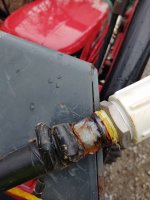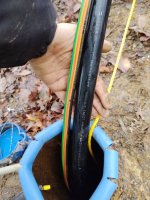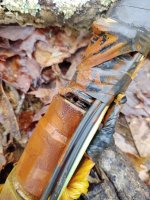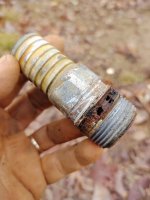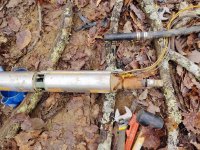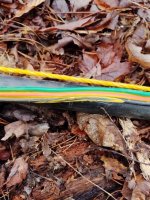My home/installation is about 4 years old. I have a 1HP/10GPM gould pump (10GS10) at about 280' with static water level at about 40'. All has been working without incident w/regard to pump and supply of water. I installed the CSV between the poly pipe and the pitless adapter about 3 months ago.
Today I noticed that the pressure gauge in the basement was dropping, pump cycling on, and no water being use din the house. The cycle stop sensor was showing uncharacteristically high current (7.5a vs. the regular 5.5ish) all the way from pump start to shut off. Hearing no water coming down the drain pipes, I assumed I have a leak between the pump and the house.
I shut off the valve coming into the house and the pressure drop on the house-side stopped. I then hiked to the well head and looked down into the shaft. When the pump shuts off, the visible water surface is rippling constantly and appears to be rising (though that is difficult to verify given the narrow field of view and depth). When the pump cycles on, the rippling appears to stop, and the water level drops again. As soon as the pump stops, the rippling and rising begins. There is no audible sound of water spraying or dripping. The poly pipe from the CSV down to the water surface appears dry.
When my son closes the valve at the pressure tank (separating the tank from the pump), the rippling immediately stops. Clearly, water is leaking back from the tank/house. The well driller/pump installer has since retired, but I did verify with him previously that there are no check valves anywhere between the pump and the pressure tank.
Aside from the cycling, the fact that the pump is drawing 7.5A indicates it's probably moving much more water than it normally takes when running up against the CSV - which makes me think maybe there is a leak in the poly. Would water exiting a failed/leaking check valve cause the water 200' up at the surface to ripple?
TL;DR:
Water appears to be returning to the shaft, presumably below the static water level. Unless the poly pipe has burst/developed a leak, the presumption is that the check valve at the pump has failed. With no other check valves in-line, and a CSV installed at the pitless adapter, I need to know what my troubleshooting/problem solving options are at this time. I would prefer to avoid pulling the pump up, but don't know how a check valve between the CSV-pitless, or poly-CSV would affect performance or reliability.
For now, I have shut the valve between the pressure tank and pump, and turned off the pump breaker so it doesn't cycle indefinitely.
Any advice would be appreciated!
Today I noticed that the pressure gauge in the basement was dropping, pump cycling on, and no water being use din the house. The cycle stop sensor was showing uncharacteristically high current (7.5a vs. the regular 5.5ish) all the way from pump start to shut off. Hearing no water coming down the drain pipes, I assumed I have a leak between the pump and the house.
I shut off the valve coming into the house and the pressure drop on the house-side stopped. I then hiked to the well head and looked down into the shaft. When the pump shuts off, the visible water surface is rippling constantly and appears to be rising (though that is difficult to verify given the narrow field of view and depth). When the pump cycles on, the rippling appears to stop, and the water level drops again. As soon as the pump stops, the rippling and rising begins. There is no audible sound of water spraying or dripping. The poly pipe from the CSV down to the water surface appears dry.
When my son closes the valve at the pressure tank (separating the tank from the pump), the rippling immediately stops. Clearly, water is leaking back from the tank/house. The well driller/pump installer has since retired, but I did verify with him previously that there are no check valves anywhere between the pump and the pressure tank.
Aside from the cycling, the fact that the pump is drawing 7.5A indicates it's probably moving much more water than it normally takes when running up against the CSV - which makes me think maybe there is a leak in the poly. Would water exiting a failed/leaking check valve cause the water 200' up at the surface to ripple?
TL;DR:
Water appears to be returning to the shaft, presumably below the static water level. Unless the poly pipe has burst/developed a leak, the presumption is that the check valve at the pump has failed. With no other check valves in-line, and a CSV installed at the pitless adapter, I need to know what my troubleshooting/problem solving options are at this time. I would prefer to avoid pulling the pump up, but don't know how a check valve between the CSV-pitless, or poly-CSV would affect performance or reliability.
For now, I have shut the valve between the pressure tank and pump, and turned off the pump breaker so it doesn't cycle indefinitely.
Any advice would be appreciated!
Last edited:

